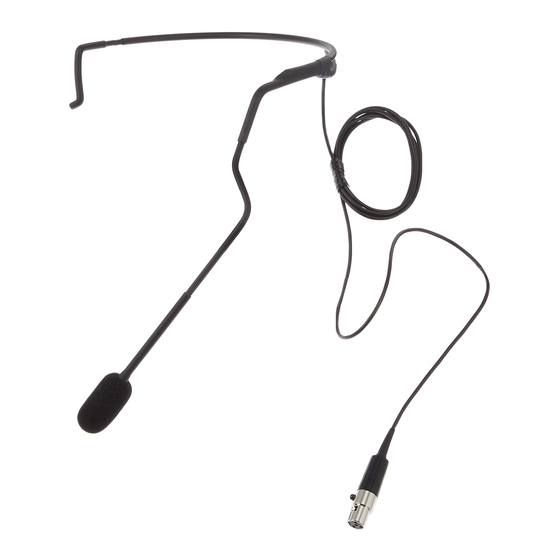Table of Contents
Advertisement
Quick Links
WCM16 -- Headset Condenser Microphone
General Description
The Shure Model WCM16 head-worn electret condenser microphone is intended for wireless use by performers,
lecturers, and others who require the highest quality voice pickup with maximum mobility. Its wide frequency re
sponse, low RF susceptibility and reliable operation at temperature and humidity extremes make the WCM16 suit
able for virtually any vocal application. When used with the Shure Body-Pack Transmitters, the performance of the
WCM16 closely resembles the finest conventional vocal microphones.
Miniaturized active circuitry included in the cartridge assembly provides equalization that tailors the low-frequency
response to resemble the warm proximity effect of larger vocal microphones. Because of this low-end response, it
is not necessary to position the microphone directly in front of the mouth, thus avoiding much popping and breath
noise, even without the supplied foam pop screen.
The microphone's hypercardioid unidirectional pickup pattern provides maximum isolation from ambient noise and
from adjacent sound sources such as musical instruments, loudspeakers and other performers. This permits high
er gain-before-feedback without loss or masking of vocals.
FEATURES:
• Extra lightweight, adjustable headband stays secure and virtually disappears while being worn
• Response comparable to the finest conventional vocal microphones
• Hypercardioid polar pattern provides maximum isolation from vocalist's own instrument and those of other per
formers
• Uniform polar pattern at all frequencies for maximum gain before feedback
• High input clipping level eliminates overload distortion
• Supplied acoustic foam pop screen
• Reliable at temperature and humidity extremes
Wearing the Microphone Headset
1. Place the microphone on the user's head so that the large diameter band is horizontal across the back of the
head. The band may be completely hidden under the hair. The ends of the headband should fit comfortably in
front of the ears. Extend or retract the adjustable headband (see Figure 1) to achieve this result.
2. For maximum gain before feedback, carefully extend or retract the boom (see Figure 1) so that the microphone
grille (silver side) is within 40 mm (1-1/2 in.) of the left corner of the mouth. It may be necessary to bend the
1/6
Advertisement
Table of Contents

Summary of Contents for Shure WCM16
- Page 1 Its wide frequency re sponse, low RF susceptibility and reliable operation at temperature and humidity extremes make the WCM16 suit able for virtually any vocal application. When used with the Shure Body-Pack Transmitters, the performance of the WCM16 closely resembles the finest conventional vocal microphones.
- Page 2 Sound sources that may cause feedback (such as monitor or P.A. speakers) or sound that you do not want to pick up with the WCM16 (such as percussion instruments or other performers) should NOT be placed directly to the rear of the microphone. It is better to adjust positioning so that unwanted sound sources are located at the 110°...
- Page 3 The WCM16 is configured for direct connection to a Shure Body-Pack Transmitter, such as models T1, T1G, T11, SC1, EC1, or LX1, using the attached cable. Microphone Powering The WCM16 is designed to be powered from the +5 Vdc source at microphone connector pin 2 of a Shure trans mitter. Specifications...
- Page 4 Shure Incorporated Signal-to-Noise Ratio 65 dB at 94 dB SPL Polarity Microphone Positive sound pressure on diaphragm produces positive voltage on pins 3 and 4 with respect to pin 1 (ground) of microphone output connector Receiver--1/4 Positive sound pressure on diaphragm produces positive voltage on tip of receiver 1/4" output in.
- Page 5 Shure Incorporated Net Weight 36 g (1.27 oz.) Figure 2: TYPICAL FREQUENCY RESPONSE Figure 3: TYPICAL POLAR PATTERNS...
- Page 6 Shure Incorporated Figure 4: TEST CIRCUIT AND WIRING Replacement Parts 4-Pin Mini Connector (TA4F/TQG) WA330 Windscreen 36A624...











Need help?
Do you have a question about the WCM16 and is the answer not in the manual?
Questions and answers